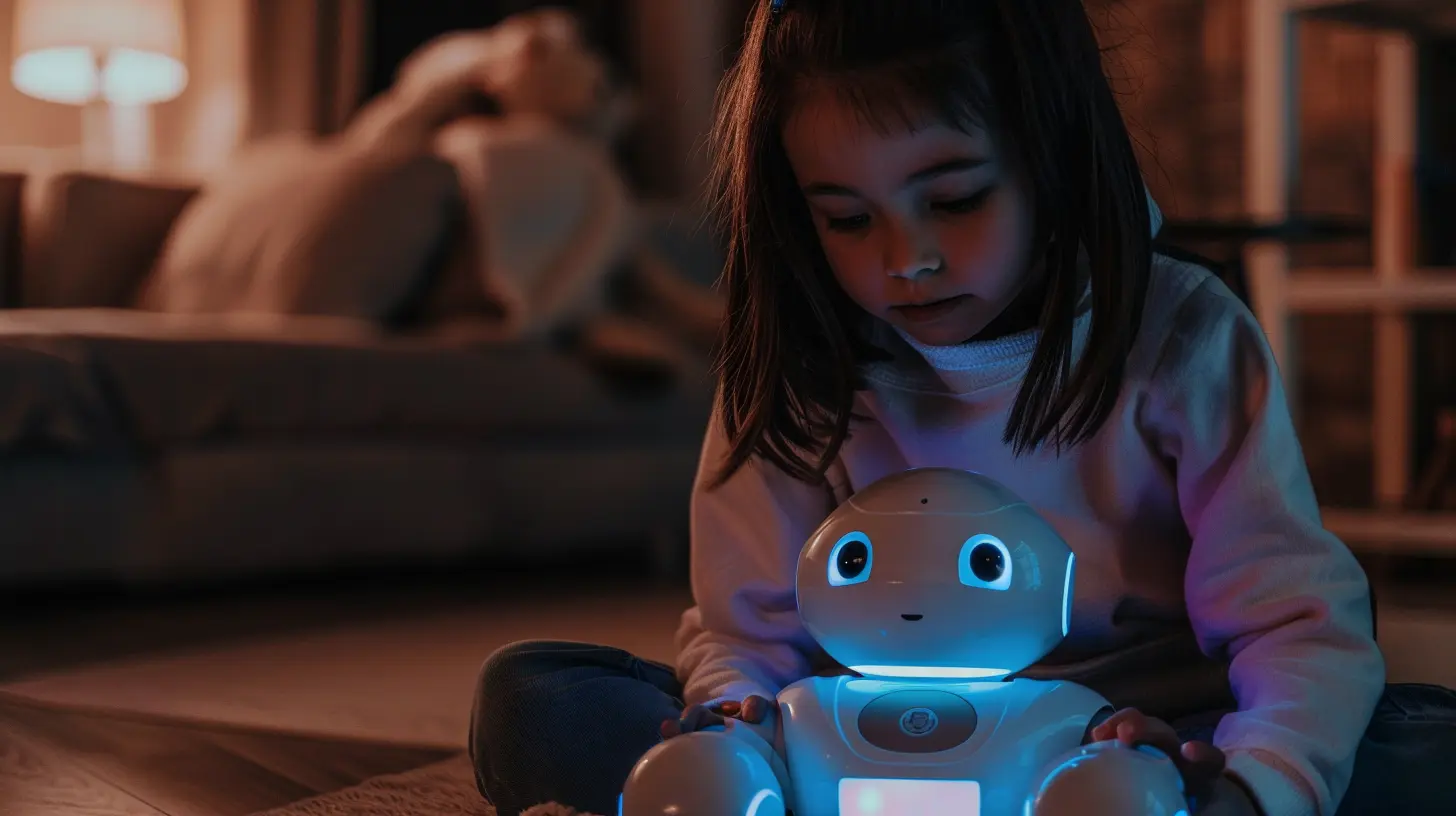Are Smart Devices Safe for Children?
14 February 2025
In today’s digital world, it seems like even toddlers know how to navigate a tablet or swipe through photos on a smartphone. On one hand, smart devices can be educational, fun, and even a lifesaver when parents need a quick distraction. But on the other hand, letting kids use these gadgets comes with its fair share of concerns.
As parents, we often find ourselves asking: "Are smart devices safe for children?" It’s a question that doesn’t come with a simple yes or no answer. Instead, it’s one of those grey areas that depends on a variety of factors like the child’s age, how much time they’re spending online, and what kinds of apps or websites they’re using.
If you're feeling conflicted about the whole thing, don’t worry, you’re not alone. In this article, we'll dive deep into both sides of the debate. By the end, you'll have a clearer understanding of how these devices impact your child's health, development, and overall well-being.

The Benefits of Smart Devices for Children
Before we dive into safety concerns, let’s first acknowledge that smart devices offer children plenty of positive opportunities.1. Educational Tools at Their Fingertips
Gone are the days when kids had to pull out a heavy encyclopedia to research a school project. Now, with just a swipe or click, they have access to limitless information on basically any topic imaginable. With the plethora of educational apps available, smart devices can be used to help children learn math, science, reading, and even coding!There are also apps designed to teach kids new languages, cognitive thinking, and problem-solving skills. What was once limited to textbooks and classrooms can now be accessed anywhere, at any time. That’s a huge benefit!
2. Staying Connected with Family and Friends
With family members living in different cities, states, or even countries, smart devices make it easier for children to stay connected. Video calls, texting, and messaging apps allow kids to chat with grandparents, cousins, or friends from school in an instant.Especially during the pandemic, smart devices also played a crucial role in keeping kids in touch with their peers when they couldn’t meet face-to-face. For kids who might feel isolated or lonely, these interactions can be a lifeline to the outside world.
3. Entertainment That Helps Build Creativity
Let’s be real: We all need a break sometimes, and smart devices can provide a quick source of entertainment for kids (and let’s face it, for parents too). Whether it’s watching a funny YouTube video, playing a creative game like Minecraft, or listening to an audiobook, the entertainment possibilities are endless.But entertainment isn’t just about mindlessly watching a screen. Many apps and platforms encourage creativity and problem-solving. Kids can create digital art, compose music, or build entire worlds in certain apps—all while having fun. At its best, technology can inspire innovation and creativity in new, exciting ways.
But, What Are The Risks?
Now, before you hand over your smartphone to your little one, let's talk about the elephant in the room: safety. Unfortunately, smart devices aren’t all fun and games. There are real concerns about how they might negatively impact children.
The Concerns About Smart Device Usage in Children
1. Screen Time and Health Concerns
One of the biggest concerns for parents is how too much screen time affects a child’s health. According to experts, excessive screen time can contribute to a variety of physical issues, including:- Poor Sleep: Exposure to blue light from screens can disrupt the production of melatonin, a hormone that regulates sleep cycles. That means your child may have trouble falling asleep, staying asleep, or getting quality rest.
- Eye Strain: Ever noticed how your eyes feel sore after staring at your phone for too long? Young children are even more susceptible to "digital eye strain," which can lead to headaches, blurred vision, or dry eyes.
- Sedentary Lifestyle: Kids glued to their screens aren’t running around and burning off energy. This can contribute to childhood obesity, as well as a lack of physical exercise that’s so critical for their development.
2. Social and Emotional Impact
There’s no denying that smart devices can get addictive. Whether they’re endlessly scrolling through YouTube, playing games, or chatting on social media, children can quickly get sucked into this digital world. Over time, this can lead to:- Reduced Social Skills: If kids are always online, they may spend less time playing with friends in person. That face-to-face interaction is crucial for developing social skills like empathy, communication, and problem solving.
- Reduced Attention Span: Ever noticed how hard it is to concentrate after spending hours scrolling through your phone? The constant barrage of stimuli from apps and games can make it harder for kids to focus on non-digital activities like schoolwork or even simple conversations.
- Increased Anxiety and Depression: Studies have shown links between excessive screen time and higher rates of anxiety or depressive symptoms in children. Social media, in particular, can exacerbate feelings of loneliness or inadequacy, especially in older kids and teens.
3. The Dangerous World of Online Content
The internet is a vast place, filled with both the good and the not-so-good. While there are educational websites, wholesome shows, and creative games, there’s also inappropriate content that your child can stumble upon without even trying. This includes:- Violence and Explicit Content: Certain games or videos can expose children to violent or explicit material that they’re not emotionally ready to handle.
- Cyberbullying: Schoolyard bullying doesn’t end at the school gates anymore. Kids can now face bullying online, sometimes anonymously, making it even more hurtful and difficult to escape.
- Privacy and Data Security: Many apps and websites collect and store personal data, and without proper controls, this information can be easily accessed or shared. Young children may not fully understand the concept of privacy, making them vulnerable to online predators, identity theft, or targeted ads.
How To Make Smart Device Use Safer for Your Children
So, are we saying to ban smart devices altogether? Absolutely not. Like many things in life—think sugary treats or late-night TV—smart devices can be enjoyed in moderation, with the right safeguards in place.Here are a few practical tips for making smart device usage a safer and more balanced experience for your child:
1. Set Clear Boundaries and Time Limits
One of the best ways to keep control over device usage is by setting clear rules. Create a family media plan where you establish when, where, and for how long your child can use a device. For example, you might limit device use to 1-2 hours a day and ban them at the dinner table or in the bedroom.Most devices even have built-in features to help parents manage screen time. You can set time limits on specific apps or even restrict the hours when the device is usable.
2. Use Parental Controls and Filters
Don’t rely only on your child’s judgment to avoid inappropriate content or apps. Make use of the parental controls available on most devices. You can block certain websites, restrict app downloads, and even monitor what your child is watching or playing.Many streaming services, like Netflix and YouTube, also offer “Kids” modes that filter out content that’s not age-appropriate. These settings can act as a safety net, ensuring that your child doesn’t accidentally stumble across harmful content.
3. Encourage Active Engagement Over Passive Consumption
Encourage your child to engage with the device in a way that promotes learning and creativity. Instead of passively binging videos or playing mindless games, guide them towards educational apps or projects. Apps that focus on coding, storytelling, or virtual building can channel their energy toward productive activities.Make sure to participate with them when possible. Watching videos or playing games together allows you to monitor content, ask questions, and make it a fun, bonding experience!
4. Promote Offline Activities and Socialization
Children’s lives shouldn’t revolve around their screens. Encourage a healthy balance by promoting activities that don’t involve screens—whether it’s playing in the yard, reading a book, or going on a family outing.Encourage your child to spend time with friends in person. Playdates, sports, or group activities provide real-world interactions that simply can’t be replaced by online communication.
Conclusion: So, Are Smart Devices Safe for Children?
There’s no one-size-fits-all answer to whether smart devices are safe for kids. The truth lies somewhere in the middle. While there are plenty of potential benefits—like learning, creativity, and connectivity—there are also risks like excessive screen time, exposure to inappropriate content, and social challenges.The key is in how you manage your child’s device usage. By setting clear boundaries, using parental controls, and encouraging active learning, you can maximize the benefits while minimizing the risks. Smart devices are a tool—one that can be used safely and wisely with the right approach.
At the end of the day, a little bit of technology isn’t the enemy; it’s how we guide our children through it that makes all the difference.
all images in this post were generated using AI tools
Category:
Tech And KidsAuthor:

Noah Sawyer
Discussion
rate this article
11 comments
Stephen McGill
Thank you for addressing this important topic! It's crucial for parents to understand the potential risks and benefits of smart devices. Your insights will help us make informed choices for our children.
March 13, 2025 at 4:33 AM

Noah Sawyer
Thank you for your thoughtful comment! I'm glad you found the insights helpful for making informed choices.
Meredith Nguyen
Balance is key; monitor usage and encourage offline activities for healthy development.
March 12, 2025 at 5:53 AM

Noah Sawyer
Absolutely! Striking a balance between screen time and offline activities is essential for healthy child development. Monitoring usage can help achieve this.
Juliana Ramirez
Balance is key for children's safety.
March 11, 2025 at 4:01 AM

Noah Sawyer
Absolutely! Striking the right balance between technology use and outdoor activities is essential for ensuring children's safety and well-being.
Elin Hunter
Balance use with active supervision.
March 6, 2025 at 4:08 AM

Noah Sawyer
Absolutely! Active supervision is key to ensuring safe and balanced use of smart devices for children.
Whitney Sharp
In a world of screens where wonders gleam, Balance is key, or so it seems. With gentle guidance, let them explore, Nurture their minds, but guard the door. Connection blooms, but watch the flow.
March 2, 2025 at 3:54 AM

Noah Sawyer
Thank you for capturing the essence of moderation! Striking a balance between exploration and protection is crucial for children's safe engagement with smart devices.
Chelsea McConkey
Smart devices can be beneficial but require careful monitoring to ensure children's safety and well-being.
February 28, 2025 at 3:59 PM

Noah Sawyer
Absolutely, responsible monitoring is key to balancing the benefits of smart devices with children's safety and well-being.
Levi McAdams
Hidden dangers lurk behind glowing screens—beware.
February 28, 2025 at 3:22 AM

Noah Sawyer
Thank you for your comment! You're right; it's important to be mindful of the potential risks associated with screen time for children.
Murphy Parker
This article raises important questions about balancing technology and childhood. I'm curious about how different smart devices impact kids' development and social skills. Looking forward to exploring this topic further!
February 25, 2025 at 3:57 PM

Noah Sawyer
Thank you for your insightful comment! It's crucial to examine the effects of smart devices on children's development and social skills. I look forward to diving deeper into this topic as well!
Thane McKinney
Balance tech use with active play to ensure safety.
February 20, 2025 at 5:34 PM

Noah Sawyer
Absolutely! Encouraging a healthy balance between tech use and active play is key to ensuring children's safety and overall well-being.
Ava Rogers
Sure, smart devices can be educational, but let’s be real: my toddler just figured out how to change my phone's language to Klingon. So, while they’re learning, I’m still in a battle for my phone’s settings!
February 18, 2025 at 4:08 PM

Noah Sawyer
It's true—smart devices can lead to unexpected challenges! While they offer educational benefits, parental controls and supervision are key to ensuring a safe experience for kids.
Spencer Price
Smart devices can be beneficial for learning but come with risks. It's crucial to monitor usage, set limits, and encourage offline activities for a balanced approach.
February 14, 2025 at 3:43 PM

Noah Sawyer
Absolutely! Striking a balance between smart device use and offline activities is essential for fostering healthy learning habits in children.
MORE POSTS

Struggling with the Pressure to Be Present 24/7

Dealing with Newborn Gas: Causes and Remedies

The Must-Have Baby Feeding Gear for Hassle-Free Mealtime

Raising Strong-Willed Kids: Finding the Balance Between Authority and Compassion

Teaching Your Child Responsibility Without Resorting to Nagging

How to Handle Working Mom Guilt and Thrive in Both Roles

Finding the Right Baby Monitor: Features Parents Should Look For

Navigating Teen Independence While Enforcing Boundaries